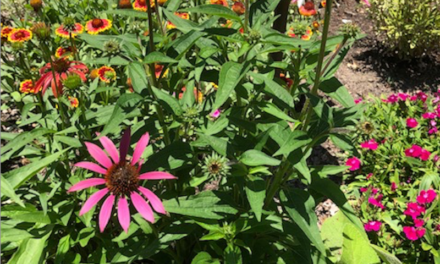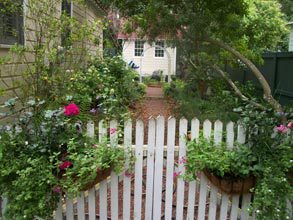
The figs this year have been more plentiful and much fatter and juicier than usual. Last year was a good year, too, but we’ve had so many it’s hard to use them all before they start getting moldy. It’s the old-fashioned Brown Turkey, a cutting shared from a long-ago neighbor’s yard, now some fifteen feet high and twenty feet wide. A handsome tree, even if it didn’t have fruit.
My nephew and his new bride wanted a fig for their new house in Charleston, so I’ve taken a couple of cuttings and have them rooting. The old tree will continue its life, fruitfully bringing sweet pleasure to a new family.
Recipes for fresh figs, especially the milder-tasting varieties like Brown Turkey, are sometimes hard to come by. My favorite fig recipe is for cake-like cookies filled with fig paste – sort of home-made fig newtons but better – but this recipe, like so many others, calls for dried figs. I did find a recipe for a fig cake using fresh figs, which I tried. The result was an extremely dense, far-too-moist cake, the result of the very high proportion of water in fresh figs. I may try the recipe again, first cooking some of the water off the figs. I must say that, even with the wrong texture and the heavy density of the original recipe, this was a fantastic taste.
There was a good crop of blueberries this year, as well. We have just a couple bushes of several varieties; they’re early, midseason, and late producing, so we’re able to get berries over a good long period. As with most of the fruits we grow, there’s the matter of how much we must share with the resident wildlife, but it usually works out pretty well. The blueberries go into breads, muffins, and pies; into jams and sauces; over ice cream; into fruit salads. Some of the bounty gets frozen into small packages and used all year, often in smoothie drinks.
I don’t talk about the pears this year. The early spring-like weather brought them into full bloom only to be zapped by sudden frost. Very few fruit on the trees survived that trauma, although the last few weeks I did notice a couple of decent pears hanging from the branches. Even those very very green pears have now been nibbled by the squirrels, found wanting, and thrown to the ground. So not one pear this year.
It’s disappointing not to have the usual bushels of pears to work with. In the past we’ve canned dozens of jars for winter use. Last year I baked giant pies filled to overflowing with the pears, froze a couple, and all were very hungrily consumed. Yep, I’ll miss those pears this year.
Forget apples. That forlorn tree is coming down. Crabapples? Although there was a respectable crop of crabapples on the trees this year, those too have been pretty decimated by the plum curculio worm. Those that escaped worm damage will face depredation from the squirrels as they redden, so I don’t expect much. These crabapples do make the most wonderful jelly, so I will regret not having any this year.
Ages ago I got a couple of quince trees – the fruiting quince, Cydonia oblonga, not the flowering quince, Chaenomeles sp. – to see how they’d do here. Not so well, it turns out, although it may have to do with their having been mowed to the ground a couple of times and chewed to nubs by deer some seasons. But the fruit is reputedly so wonderfully fragrant, so amazingly delicious in jellies, I felt I should try. So those two struggling quince trees slowly add on a few inches each year, making a few flowers but no fruit. Eventually, perhaps, there will be quince jelly to share.
It’s too early to know how the pecan trees will do. The years we have a bumper crop are joyous ones both for us and for the wildlife. There are two dozen pecan trees around the old farmhouse; they’ve been here for half a century for the young ones, much longer for the giants closest to the house. Some were planted for the quality of their nuts; some are seedlings of those more glamorous parents, sprung up where a foothold for growing was found.
The very best of these pecans is the one in the field going over to the old cemetery in the pines. This big old tree spreads its handsome limbs nearly fifty feet across. Its nuts, however, are quite small – about the size of the last joint on my thumb – and quite hard-shelled. They’re not that easy to shell, but they are absolutely packed with flavor. And this is one of those seedling trees, of mixed parentage, completely lacking in the carefully-bred-for characteristics of size and ease of shelling. A mongrel. And a prized tree, as well.
I cannot think of a more-utilized product grown on the farm than the pecans. I am absolutely crazy for them; I use them in almost everything. I put them in breads; on salads; in pasta; on cheesecake; in a butter sauce over green beans; in a crust on fish. I make a killer Hoppin’ John each New Year, and it would be only half as good without my pecans. I make stuffed collards instead of cabbage, and I use pecans in the filling. I put pecans in my rice. If I’m serving ice cream, I toast and chop some pecans to sprinkle over it. I love my pecans!
There are two grape arbors with both muscadines and scuppernongs on them. The year before my father died, he was proudly watching over his developing crop of grapes. Each week when I’d visit, I’d check on their progress, and we’d speculate how much longer before they’d be ready to pick.
One weekend I drove up to the farm and went over to the arbor with the grapes I was certain would be absolutely ready for picking. Not one grape on the vines at all; not one! I went in to my father to ask when he’d picked them. He was quite surprised – he hadn’t picked them yet. Someone – someone – had overnight crept up and stolen every single muscadine. We spent the day trying to decide who could have been so rude.
I went home after the weekend, and I thought a great deal about this theft. I began to search the internet for ideas. After a couple hours of aimless googling, I came across a photograph of a big deer that had been shot. In the process of dressing the deer, after making the cut to remove the viscera, the photo showed the contents of its gut: nearly a bushel of ripe muscadines, whole, purple and unmistakable.
Mystery solved; it was the deer that had consumed every one of my father’s prized grapes in one night. If it ain’t the squirrels, it’s the deer. Nothing is safe.
There certainly was no muscadine wine made that year!
Will Balk, Jr., is a Master Gardener who grew up on an Agricultural Experiment Station in Barnwell County as the son, grandson, and great-grandson of accomplished gardeners. He is a past president of the Lowcountry Master Gardener Association. Currently he gardens on the family homestead in Barnwell County and tries to fight back the jungle in Northern Beaufort County. Will is also an occasional contributor to www.weeklyhubris.com






